Roxham
Michel Huneault
2018
| 15 min
Accessible in virtual reality and online
Selections and Awards
Official SelectionFIPADOC 2019
Interactive Production - Documentary NomineeNumix Awards 2019
Nomination Best Interactive Experience: All Categories Prix Gémeaux 2019
Official Selection & FinalistVR Arles Festival 2018
Official SelectionOpen City Documentary Festival 2018
Official SelectionCamden International Film Festival 2018
FWA of the DayThe FWA Awards 2018
Official SelectionFantasia Film Festival 2018
www.nfb.ca/roxham
Created by Michel Huneault, with Maude Thibodeau and Chantal Dumas, produced by the NFB, in collaboration with Le Devoir, Phi and Dpt.
– Stop! If you walk further, you’ll be arrested.
– I know; I am really sorry. You have to help us; we are entering.
In early 2017, the number of asylum seekers arriving at Roxham Road sharply increased. This quiet and practically unknown road between the United States and Canada became the location with the largest number of irregular border crossings in the country.
The Roxham experience takes us to the moments when Royal Canadian Mounted Police (RCMP) officers intercept these individuals in exchanges that are as regulated as they are tense.
Documenting 180 border-crossing attempts over a period of 16 days between February and August 2017, Michel Huneault captured the stories of these individuals in images and sound, and now he is sharing them through a virtual reality project created in collaboration with interactive designer Maude Thibodeau (Dpt.) and sound designer Chantal Dumas.
In the photographs, the asylum seekers are shown in silhouette. Composite images of various fabrics shield their identity, preserving their anonymity. These textures come from another photo series Huneault made during the 2015 European migrant crisis. Alluding to both protection and comfort, these textiles serve as a reminder that the two situations are part of the same larger story.
At Roxham Road—just like in the immersive experience—the border is invisible, and the confusion is palpable. The language barrier is magnified; emotions run high. Migration, an exceedingly personal decision, has been thrust to the forefront of public and political debates. Roxham Road is quickly becoming symbolic: it embodies the tensions between the international responsibility to welcome others and the duty to protect a national territory.
In this seven-part experience, the 10-metre-wide Roxham Road becomes a microcosm of the world’s crises, offering a personal glimpse into the confusing quest for a safe place.
This immersive story centres on Roxham Road, a small section of the border where people are arrested and welcomed at the same time. Photographer Michel Huneault documented border interceptions of asylum seekers moving from the United States to Canada and their confusing quest for a safe place.
Creator's Statement
– Stop! If you walk further, you’ll be arrested.
– I know; I am really sorry. You have to help us; we are entering.
Roxham Road is the location with the largest number of irregular border crossings by asylum seekers moving from the United States to Canada. On this otherwise calm rural section of the border, the number of arrivals climbed sharply throughout 2017.
There I documented 180 attempted border crossings over 16 days between February and August 2017. The people I saw had come from more than 20 countries: Eritrea, Sudan, Syria, Pakistan, Colombia, Turkey, Yemen, Guatemala, Haiti, El Salvador, Chad, the Philippines, Nigeria, Burundi, and several others. Roxham is a true microcosm of today’s crises and conflicts. A worldwide migratory movement comes toward us there, periodically prompted by the politics of the Trump administration.
On my first day at Roxham, a young, pregnant Nigerian woman approached the border with her suitcases. When the RCMP officers warned her not to cross the border, she froze with her feet sinking into the snow-covered ditch. She hesitated, crying. She begged to be allowed to enter Canada. Minutes passed, and then an American officer arrived on the other side of the border. He picked her up, and she disappeared. It was my first time seeing someone attempt to cross the border, and it shook me.
From that first day, I wondered how to document this historical moment without putting the vulnerable asylum seekers further at risk. I decided to mask their silhouettes using fabric I photographed in other places during the 2015 European migrant crisis—images of blankets in Hungary, clean clothing offered to migrants in Austria, or details of tents set up for migrants in Germany. Using this fabric protected their identity and reminded me that this too was part of the same story.
Roxham Road is quickly becoming symbolic. This intensely personal moment—when people choose to change their life by crossing an invisible line—is also, essentially, a public moment with political and legal debates surrounding it. Yet, these people aren’t “illegal,” and neither is their border crossing. In 1951, Canada signed a convention to welcome all people who present themselves to authorities seeking asylum, no matter where they arrive. Thus, this crossing is irregular but not illegal, and these individuals are asylum seekers—completely legal.
Nevertheless, during this brief moment, the international responsibility of welcoming asylum seekers clashes with the duty to protect a national territory. Confusion reigns, and the tension is palpable. Language is a barrier in itself; emotions run high.
At Roxham, standing on the edge of the border, a changing world comes toward us.
Michel Huneault
Montreal, March 2018
Glossary: Words matter. So which ones should be used?
Migrant, Refugee or Asylum Seeker
Migrant: A general, imprecise term used for any person who has left his or her habitual place of residence, regardless of the reasons for the movement, whether or not it is voluntary, or the person’s legal status.
Asylum Seeker: A person who is seeking the legal status of a refugee but who has not yet received it. As long as the refugee claim is in process, the individual is called an asylum seeker, a synonym of refugee claimant.
Refugee: A person who has fled his or her home country and has received the protection of another country due to the fear of being persecuted for reasons of race, religion, nationality, political opinion or membership in a particular social group.
The 1951 Refugee Convention’s definition of a refugee is included in Canadian law.
TO AVOID
“An Illegal” or “Illegal Migrant”
Only an act can be illegal, not an individual. A person may commit an illegal act, but that does not make the person illegal.
“For example, a person who has not paid his or her taxes on time, or in full, is not usually described as an illegal taxpayer,” writes Louise Arbour, United Nations Special Representative for International Migration.
“Irregular” Migrant
This follows the same reasoning: A person cannot be irregular. It’s the way in which the individual enters the country that is irregular—the crossing is irregular.
A person can be “without status,” but only after the individual’s asylum claim has been refused and he or she has exhausted all possibilities of recourse. Thus, the people photographed by Michel Huneault are not “without status,” but rather “asylum seekers.”
“Illegal” Border Crossing or “Illegal” Entry
These border crossings are irregular but legal. The 1951 Refugee Convention, signed by Canada, specifies that people who seek asylum will not be criminally punished.
In the Roxham experience, you will hear the Royal Canadian Mounted Police (RCMP) say that it is “illegal” to cross. They give this warning before the person crosses the border and requests asylum.
In short: The border crossing is “irregular” but not illegal, and the individual is a completely legal asylum seeker.
Why Are People Crossing at Roxham Instead of at an Official Border Checkpoint?
The convergence of three important responsibilities on the part of Canada leaves very few options to people who want to cross.
1. The Sovereignty of a National Territory. The authority—the exclusive jurisdiction—of a State over its territory authorizes it to protect its borders.
2. A Commitment to Welcome. The 1951 Refugee Convention on the protection of refugees, signed by Canada, states that people who seek asylum will not be subject to criminal punishment.
3. Safe Third Country Agreement. Signed with the United States, this agreement came into effect in 2004. The principle is simple: A person makes an asylum claim in the country where he or she arrives first. An asylum seeker who had first arrived in the United States would be turned away at the Saint-Bernard-de-Lacolle Border Crossing Station in Quebec, for example. This rule applies only to those who make a claim at a border station. It does not apply to a person who crosses at an irregular point of entry.
Arrest Versus Interception
The RCMP officers do indeed arrest asylum seekers, since they are responsible for border security. However, no charge is made against those who cross the border, since they are asking for asylum (Article 31 of the 1951 Refugee Convention).
These “arrests” are counted as “interceptions” in the RCMP statistics.
References:
Technical Specifications
Roxham runs in WebVR on Oculus Rift and HTC Vive through your browser, as well as on Samsung Gear VR. The project is also accessible online (2D) through all mobile devices and computers.
Why WebVR in general:
We support the open and democratic web being a public institution funded by the public. We believe that open web standards allow everyone to enjoy our content and be able to create content as well to express themselves. WebVR is a great example of how we can innovate what the web can do and still keep this progress accessible to everyone.
Trailer
Demo
Images
Loading...
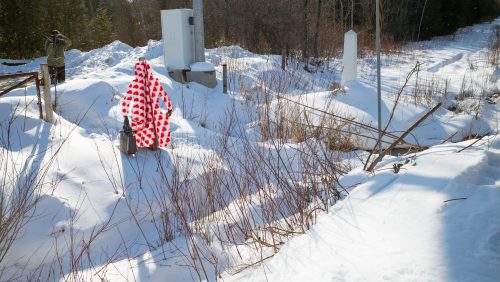
Download
Loading...
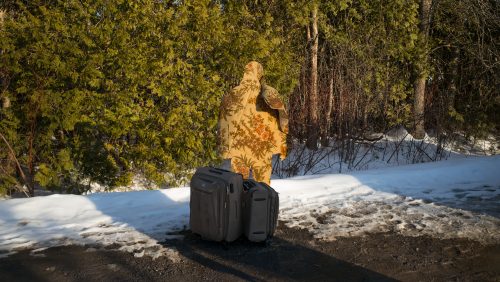
Download
Loading...
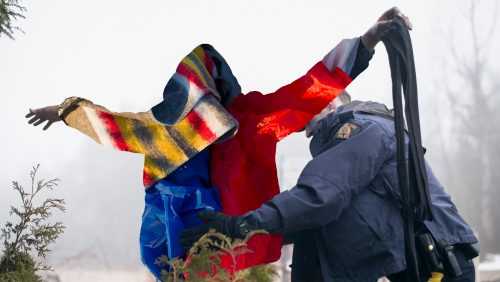
Download
Loading...
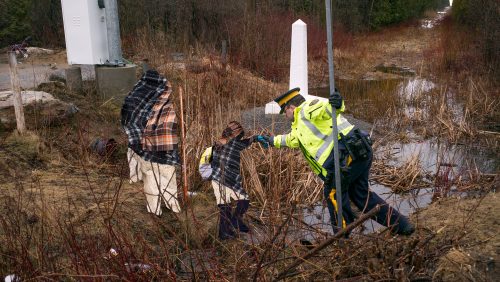
Download
Loading...
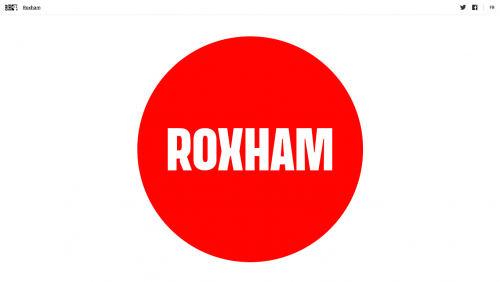
Download
Loading...
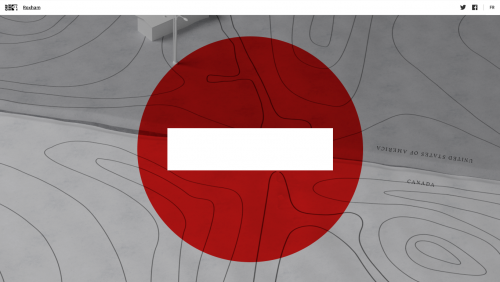
Download
Loading...
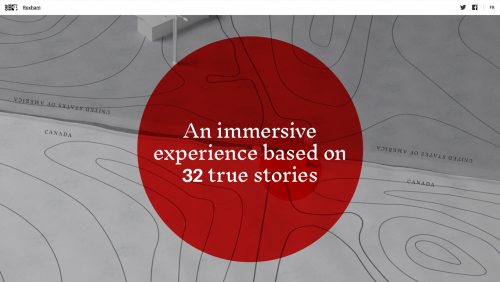
Download
Loading...
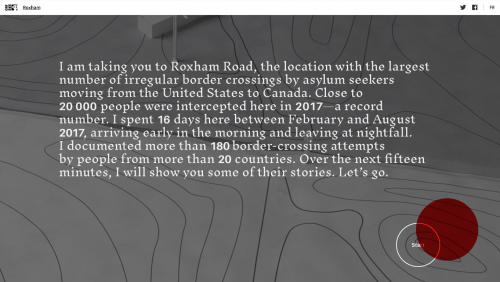
Download
Loading...
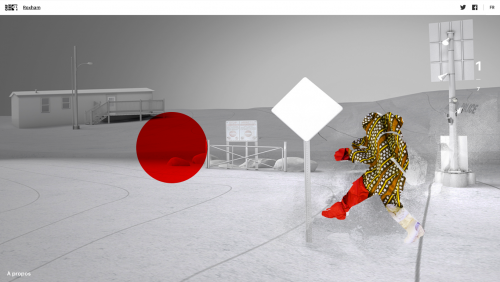
Download
Loading...
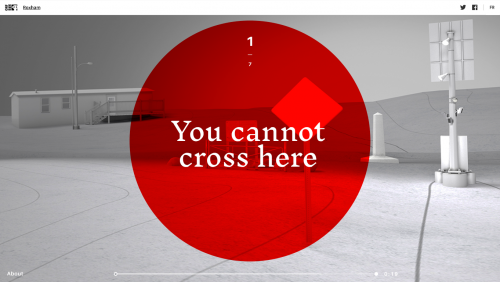
Download
Loading...
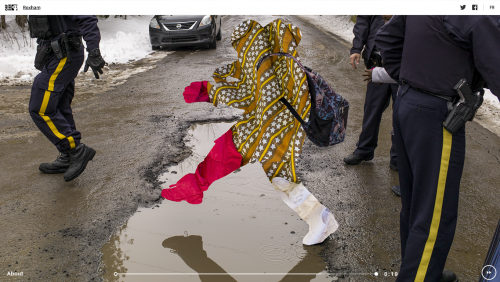
Download
Team
Michel Huneault
Creator
Photo
Photo : Joannie Lafrenière
Maude Thibodeau
Experience Director (Dpt.)
Photo
Photo : Anouk Lessard, L'Éloi
Chantal Dumas
Sound Designer
Photo
Photo : Pamela Gallant
Hugues Sweeney
Producer & Executive Producer
Photo
Credits
Created by Michel Huneault,
with Maude Thibodeau
and Chantal Dumas, produced by the NFB,
in collaboration with Le Devoir, Phi and Dpt.
Original Idea, Ideation, Photography,
Sound Recording, Text and Narration
Michel Huneault
Sound Design and Audio Mix
Chantal Dumas
Set Director
(Narration Recording)
Benoît Rousseau
Dpt. Team
Ideation and Experience Design
Maude Thibodeau
3D Artist
Hugo Forget
Programming
Stéphane Demotte
Producer
Geneviève Trépanier
Creative Director
Nicolas S. Roy
NFB Team
Executive Producer
Hugues Sweeney
Production Manager
Marie-Pier Gauthier
Editorial Manager
Valérie Darveau
Technology Director
Martin Viau
Production Coordinators
Marie-Ève Babineau
Claudia Boutin
Dominique Brunet
Caroline Fournier
Administrator
Marie-Andrée Bonneau
Marketing Manager
Tammy Peddle
Marketing Coordinator
Stéphanie Quevillon
Social Media Strategist
Kate Ruscito
Community Managers
Alyssia Duval-Nguon
Mélissa Sauvé
Web Content Project Manager
Félix-Antoine Viens
Press Relations
Marie-Claude Lamoureux
Information Technology
Sergiu Suciu
Legal Services
Hugo Barnabé
English Translation and Revision
Jenny Montgomery
Special Thanks
Louise Arbour
Stéphanie Beaudoin
Sophie Bertrand
Adil Boukind
Catherine Bourassa-Hébert
Laurence Butet-Roch
Michel Campeau
Sarah R. Champagne
André Dufour
Seif Elhamoud
Hubert Hayaud
Tarin Hughes
Joannie Lafrenière
Pierre-Alexandre Lapointe
Karine Laurier
Sophie Mangado
Edward Maloney
François Pouliot
Émilie Régnier
Susana Reisman
Fanny Rodrigue
Claire Sykes
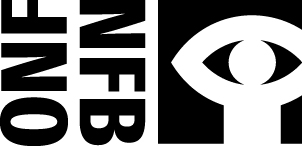

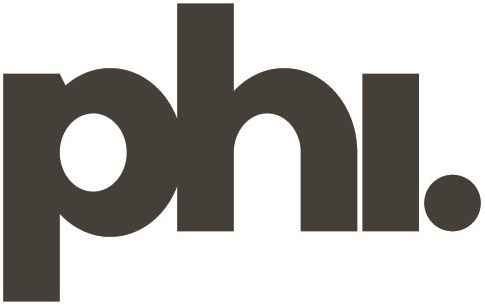
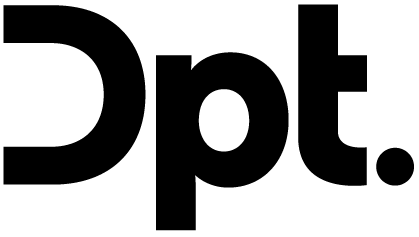
Media Relations
-
About Dpt.
Dpt. is a digital studio crafting award-winning immersive and narrative experiences. We conceptualize, design and build content-driven work for brands and museums as well as for the entertainment, film and education industries.
-
About the NFB
The National Film Board of Canada (NFB) is one of the world’s leading digital content hubs, creating groundbreaking interactive documentaries and animation, mobile content, installations and participatory experiences. NFB interactive productions and digital platforms have won over 100 awards, including 21 Webbys. To access this unique content, visit NFB.ca.